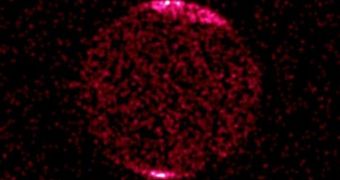Recent observations conducted using the NASA Chandra X-ray Space Telescope revealed that energetic radiations emanating from Jupiter's northern hemisphere are in fact originating in a single hot spot. In other words, they are not produced over a larger surface area, as originally thought.
What's more, the studies showed that the hot spot producing the northern aural X-rays was pulsating at regular, 45-minute intervals, which is also unusual. Interestingly, this is not the first time such pulsations were found at the gas giant.
During flybys conducted years ago, both the Galileo and Cassini orbiters discovered radio pulses being emitted from high in the Jovian atmosphere, also at regular intervals. Having radio and X-ray sources located close to each other, and so close to the planet's north pole, was very unexpected.
According to astrophysicists, X-rays may be produced by energetic oxygen and sulfur ions, which are electrically-charged versions of the standard atoms. They are trapped in the gas giant's magnetic field, and continuously crash into its atmosphere.
Before Chandra observed Jupiter for its entire 10-hour rotation, experts were convinced that these ions were originating in areas near the orbit of Io, one of the planet's moons, Daily Galaxy reports.
But the recent observations appear to indicate that this explanation is impossible, since ions from Io's orbit could not possible climb to such high latitudes, and get so near to the North Pole. This implies that the ions must come from much farther away than the nearby moon.
One potential explanation researchers thought of is that the particles come from the Sun. As they reach the outer layers of the strong magnetic field surrounding the gas giant, they start to undergo a process of acceleration, which eventually aims them at the planet's magnetic poles.
As they ricochet off the magnetosphere, the ions may literally be bounced back and forth between X-ray hot spots at the Jovian north and south poles. This repetitive motion could account for the pulsation that Chandra's sensitive detectors identified.
Experts are now convinced that they have a lot to learn about the second largest object in the solar system. Over the years, the necessity of sending a flagship mission to Jupiter has been made increasingly clear.

 14 DAY TRIAL //
14 DAY TRIAL //